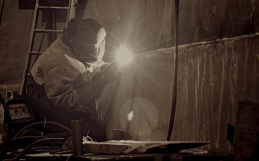Metal fabrication broadly refers to any process involving cutting, molding or shaping metal material into a variety of products. These products may include metal parts, components, or even machinery. Fabricated metal products can be created with welding, lathing, drilling, broaching, grinding, milling and honing.
The metal components used during fabrication, such as rods, bars and sheet metal, come in many different types of metals. Popular types of metal that are available for fabrication include aluminum, brass, copper, gold, iron, nickel, silver, magnesium, and steel.
Some of the raw materials used in the fabrication process include:
– Plate metal
– Fittings
– Castings
– Formed and expanded metal
– Hardware
– Sectional metal
– Flat metal
– Welding wire
Besides the flexibility in material choices, fabrication shops are capable of creating products in a wide range of shapes and sizes. This lends itself to plenty of custom metal fabrication services.
Types of Custom Metal Fabrication Services
When manufacturers, contractors, resellers or other types of metal fabrication clients need custom work done, fabrication shops can not only meet their needs, but also provide additional help throughout the product development process:
Custom Design
This is the conceptualization, creation, or analysis of the characteristics of parts and products. Manufacturing a custom metal product will often require a good amount of design and planning. Preparation is critical during the design process, otherwise it could result in structural issues and faulty dimensions. Even the slightest deviation can result in poor quality.
Problems arising from the outset can be avoided by considering any or all of these custom design services:
- Conceptualizing. When customers provide general ideas about their vision for a product, conceptualization can help figure out the materials and parts that work best to get the desired results.
- Computer-aided design (CAD). The computer-generated, three-dimensional results you get from CAD programs help metal fabrication customers identify potential issues prior to production.
- Tooling design. Fab shops can also help design specialized production tools.
Custom Build Services
After the design phase is done, manufacturing can start. The fabrication method choice depends on various factors, such as its geometry, the materials being used and what the final product is meant to do.
Custom Finishing and Assembly Services
This stage involves post-fabrication treatments to improve the product. Some custom metal products need secondary finishing treatments to meet specifications. Assembly services may be necessary, which may include combining multiple components into a single unit. This may include adhesive bonding, bolting deburring, grinding, riveting, screwing, sawing and painting.
If you have a metal fabrication project in mind or you have additional questions about the process, feel free to contact CE Metal Fabrication. We’ll be happy to assist you.
.





